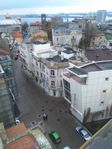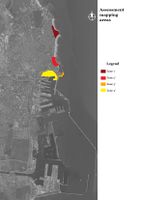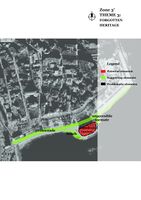Constanta
>>>back to working groups overview
| Area | Z3 | |
| Place | Constanța | |
| Country | Romania | |
| Topics | Coastal development; urban coast; urban waterfront | |
| Author(s) | Wendy Laura Cînța, Simona Dolana, Ioana Natalia Oneșciuc, Mihai Surdu | |

| ||
Rationale
The complexity of the Constanta case study consists in the fact that it, as a big city of Romania (of around 300 thousand inhabitants), is at the same time a strategic point on a continental scale. This is due to the favourable location on one of the most important geostrategic axes of the European continent, the Rhine-Danube TEN-T Corridor and the fact that it is the largest port on the entire Black Sea basin. In the context of Constanta, the concept of "resource" should not be limited to the port element as an urban development factor, but should be extended to include the entire coastline, as a responsible element of increasing the site's quality.
Location and scope
You can edit this map with the map editor
A Landscape System Analysis
A.1 Landscape layers and their system context
Geomorphology, landscape units and coastal typology
The shoreline has great stability, but it suffers from a continuous but slow withdrawal process, that generates landslides that look like false terraces. Erosion, especially due to socio-economic pressure, affects the complex geological structure of the coastline.
Land use
The main characteristic is intensely urbanized area with a fragmentary use of the land. The city and the port are 2 distinct areas, both from a landscape scenery point of view and also from an administrative one. Recent redistribution of land use patterns (e.g. residential) was possible due to an imbalance of land price, which has resulted in an urban landscape reconfiguration.
Green/blue infrastructure
Agigea Marine Dunes (south) - biosphere reserve territories (north) corridor is characterized by terraced landscape unit as a topographic facility in connection to the park/s meeting lake/s (Siutghiol and Tăbăcăriei), apart from the Black Sea’s green shoreline. Intense urbanization affects these elements. Moreover, there is huge potential for the reconversion of the former industrial derelict sites.
Actors and stakeholders
Almost the entire coastal area can be accessed and used by the public, so many different users and stakeholders are interested in the coastline. Even if the government and the local municipality regulate the whole studied area, there are other stakeholders with an impact, such as business developers and the Constanța port. Despite not having a strong participatory culture, recent years have brought up an undersized critical mass of activists comprised of NGOs, local initiative groups and professionals working in the planning/environmental sectors, together with journalists bloggers and lobbyists, militating on behalf of the local community.
Sacred spaces and heritage
Constanța/Kustenge/Kustendje(h)/Tomis is a layered archaeological, architectonic, pluri-ethnic spiritual harbour site abundant in monuments (the Ancient City of Tomis), thus revealing the multicultural identity of the city and its great history, partly affected also by the World Wars attested through the presence of bunkers and documents revealing restoration processes of monuments. The port area is characterized by a vast industrial heritage site with renowned monuments dating from the early twentieth century.
Visual appearance and landscape narrative
For the last century, the Romanian coastline inspired tens of famous authors, painters and lately, directors and singers. The Casino along with its promenade, the city’s landmark, was depicted in Cella Serghi’s autobiographic novel ,,Spiderweb” and also, later, by art historian Doina Păuleanu and architect Radu Cornescu; it also appears in many paintings. Besides the valuable cultural heritage layered from various generations and ethnicities, another essential element for the landscape character is the abandoned waterfront.
Authors:
Cella Serghi – Pânza de Păianjen (Spider Web)
Jean Bart – Europolis
Tudor Ganea – Cazemata (The Casemate) Painters: Nicolae Vermont, Peisaj marin cu portul Constanța (Marine landscape of the Constanța port); Plajă (Beach) (see image 1)
Marius Bunescu, Înainte de furtună (Before the storm) (see image 2)
Arthur Verona, Violonist în barcă (The violinist on the boat) (see image 3)
Theodor Pallady, Peisaj din Constanța (Constanța’s landscape) (see image 4)
Nicolae Grigorescu, Femeie pe malul mării (The woman on the seashore) (see image 5)
Directors:
Francis Ford Coppola - Youth without Youth Rian Johnson - The Brothers Bloom
Savel Stiopul – Aventuri la Marea Neagră (Black Sea Adventures); Nea Marin Miliardarul (Marin the billionaire)
Singers:
B.U.G. Mafia - Pe Coastă (On the coast) – (you can listen to the link - https://www.youtube.com/watch?v=7fc9jhvzjSg)
Inna - Spre mare (By sea) – (you can listen to the link - https://www.youtube.com/watch?v=5wqJ1E5cXLw)
Vama veche - Vino să visăm sub apă (Come to dream under water) – (you can listen to the link - https://www.youtube.com/watch?v=oHcWjSH6_a8)
A.2 Summary of you landscape system analysis and your development Targets
Chaotic urbanization poses environmental problems in the studied coastal context, so making cities and human settlements inclusive, resilient and sustainable objective is at risk.
We hypothesise that different coastal patterns driven by environmental, historical, cultural and economic discrepancies between northern Constanța and southern Agigea (poor coastal planning) lead to coastal degradation.
A.3 Theory reflection
- Reflect on at least three international policy documents in relation to their local landscape case
- choose one international, one European and one national document
- You can choose references from our reading list
- Scope: 250 words
A.4 References
1. MONITORING OF COSTAL EROSION, THE MAIN INSTRUMENT IN THE ASSESSMENT OF THE GEOMORPHOLOGICAL STATUS OF THE ROMANIAN COUNTRY - TRADITIONS AND PERSPECTIVES. Available at: http://www.agir.ro/buletine/2431.pdf (accessed on 07/06/2018).
2. The 10 problems of Romanian coastal zone. Available at: https://www.ziuaconstanta.ro/diverse/stiri-calde/ziua-internationala-a-marii-neagre-cele-10-probleme-ale-zonei-costiere-romanesti-612805.html (accessed on 07/06/2018).
3. DEVELOPMENT TERRITORIAL STRATEGY OF ROMANIA. Available at: http://www.fonduri-structurale.ro/Document_Files/Stiri/00017493/7hctm_Anexe.pdf (accessed on 07/06/2018).
4. Ten historic sites to visit the Black Sea. Available at: https://www.historia.ro/sectiune/general/articol/10-obiective-istorice-de-vizitat-la-malul-marii-negre (accessed on 07/06/2018).
5. The official list of historic monuments and heritage sites in Constanța - revision 2015. Available at: https://patrimoniu.gov.ro/images/lmi-2015/LMI-CT.pdf (accessed on 15/04/2018).
6. The Ancient City of Tomis. Available at: https://ro.wikipedia.org/wiki/Ora%C8%99ul_antic_Tomis (accessed on 07/06/2018).
7. The Port of Constanța - official page. Available at: http://www.portofconstantza.com/apmc/portal/static.do?package_id=comunitate&x=load (accessed on 07/06/2018).
8. Constanța magnet-city - World Bank Report on Romanian Magnet-Cities. Available at: https://openknowledge.worldbank.org/handle/10986/27874 (accessed on 10/05/2018), http://www.ct100.ro/video-constanta-oras-magnet-unul-din-cinci-romani-ar-alege-sa-se-mute-aici/ (accessed on 12/05/2018).
10. World Bank Report on Romanian Magnet-Cities - Constanța Municipality/Metropolitan Area Debate 9 Febr. Available at: https://youtu.be/W29d_T5zoak (accessed on 13/05/2018).
11. Constanța magnet-city - perception at local level. Available at: https://www.ct100.ro/banca-mondiala-primaria-constanta-si-alba-ca-zapada/ (accessed on 13/05/2018).
12. CET area. Available at: http://www.radet-constanta.ro/index.php (accessed on 11/06/2018).
13. Local NGOs fighting for transparency and sustainable urban development in Constanța city in relation to public investments in roads rehabilitation. Available at: https://www.ziuaconstanta.ro/stiri/administratie-locala/asociatia-eco-dobrogea-despre-reabilitarea-strazilor-termele-romane-si-traian-vor-fi-taiati-copaci-nu-este-prevazut-tranzitul-velo-trotuarele-657204.html (accessed on 24/04/2018).
14. Public investments in roads rehabilitation in Constanța city. Available at: https://www.ziuaconstanta.ro/stiri/imobiliare/drumul-si-platformele-din-spatele-silozurilor-modernizate-de-cn-apm-sa-constanta-654947.html (accessed on 24/04/2018).
15. Public investments in roads rehabilitation in Constanța city. Available at: https://www.ziuaconstanta.ro/stiri/justitie/incepe-haosul-pentru-soferii-din-constanta-sens-giratoriu-amenajat-ca-insula-circulara-cu-spatiu-verde-si-trotuare-refacute-653440.html (accessed on 24/04/2018).
16. Local debate initiated by the NGO sector for awareness raising on the attractiveness of Constanța city in relation to sustainable urban mobility concepts and inclusive participatory urbanism. Available at: https://expertforum.ro/dezbatere-locala-constanta-atractivitate-mobilitate-si-urbanism-participativ/ (accessed on 05/06/2018).
Phase B: Landscape Evaluation and Assessment
B.1 Assessment Strategy
Overall goal: Identifying and analyzing what are the potential harming features, depending on the character of the zones:
Zone 1 – Community beach - goal: existing open free public space for the community, along the existing promenade;
Zone 2 – Community and tourism beach - goal: free beach public space for the community, as well for tourists who can visit Constanța throughout the year;
Zone 3 – Tourism harbour area – goal: existing open free public space close to historical landmarks;
Zone 4 – Industry and port area – goal: existing unused space properly close to/in the industrial heritage units.
Depending on the context, the elements to be mapped are potential elements, the supporting elements and the problematic elements.
B.2 Mapping
B.3 Problem definition and priority setting
The four subzones have different characteristics, so different problem/potentials elements have been identified.
In the first subzone, several land reserves for the community were identified, so that these elements highlight the potential element, the existing promenade, but discontinuous. The priority lies in the identification and improvement of some walkways that can provide links with free open space planning for this subzone.
In the second subzone, the potential element is a hillock (Neagoe's hat) on Modern Beach. In a context where this beach is divided into several private beaches, this free public landmark becomes a priority in the process of creating an identity, a transition between community and tourism areas.
The third subzone is the main attraction of tourists and residents of Constanța. Here, open free public areas are almost non-existent (loss of open free space), so this area can be highlighted by organizing different events (as it has just begun to happen lately). However, there is a potential place in the Casino area, namely the existence of a very small beach that attracts many visitors.
The fourth subzone has the potential to be the city's inhabitants, the visitors and the port connector. Here the priority lies in the opening of the industrial heritage to everybody, but also the functional reconversion of it.
- Your case problems potentials map.jpg
add caption here
B.4 Theory reflection
- Please reflect the assessment and evaluation methods used based on at least three readings
- Did you encounter limitations'
- 200 words test contribution
B.5 References
- give a full list of the references you have used for this section
Phase C – Strategy and Master Plan
C.1 Goal Setting
- Define strategic planning objectives based on the evaluation findings
- Link back to your original targets from section one and the Development Goals
- 150 words text contribution
C.2 Spatial Strategy and Transect
- translate your strategic goals into a vision
- develop a spatial translation of your vision
- exemplify your vision in the form of a transect with concrete interventions
- add map(s) and visualizations
- Your case spatial translaton vision.jpg
add caption here
- Your case transect.jpg
add caption here
- Your case transect detail1.jpg
add caption here
- Your case transect detail2.jpg
add caption here
C.3 From Theory of Change to Implementation
- For implementing your vision: Which partnerships are needed? Which governance model is required?
- Who needs to act and how? Draw and explain a change/process model/timeline
- Which resources are needed? On which assets can you build?
- add 150 words text and visuals
- Your case spatial your governance model.jpg
add caption here
- Your case spatial your process model.jpg
add caption here
C.4 References
1. DIRECTIVE 2014/89/EU OF THE EUROPEAN PARLIAMENT AND OF THE COUNCIL. Establishing a framework for maritime spatial planning. Available at: https://eur-lex.europa.eu/legal-content/EN/TXT/?uri=celex%3A32014L0089 (accessed on 14/06/2018);
2. Examining the Ocean and Coastal Governance Framework in Trinidad and Tobago. Transitioning Towards Integrated Coastal Zone Management. Available at: http://www.un.org/depts/los/nippon/unnff_programme_home/fellows_pages/fellows_papers/Hassanali_1314_T&T.pdf (accessed on 14/06/2018);
3. Coastal Governance Index 2015. Available at: https://www.oceanprosperityroadmap.org/wp-content/uploads/2015/05/EIU_CGIndex_WEB-revised-June-4.pdf(accessed on 14/06/2018);
4. Developing an effective governance operating model. A guide for financial services boards and management teams. Available at: https://www2.deloitte.com/content/dam/Deloitte/global/Documents/Financial-Services/dttl-fsi-US-FSI-Developinganeffectivegovernance-031913.pdf(accessed on 14/06/2018);
5. Maritime spatial planning. Available at: https://ec.europa.eu/maritimeaffairs/policy/maritime_spatial_planning_en(accessed on 14/06/2018).
D. Process Reflection
- Reflect in your intercultural and interdisciplinary team on the outcomes of your study
- Which limitations were you facing?
- What have you learnt from each other?
- What would you do differently next time?
- You can also use diagrams/visuals
- 250 words text






















